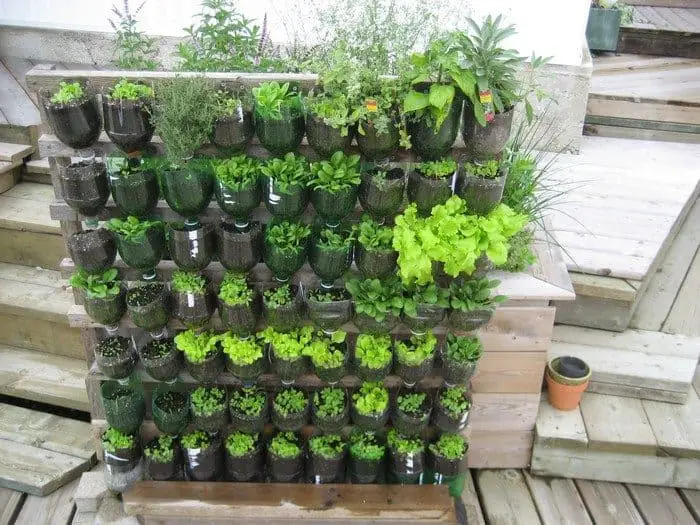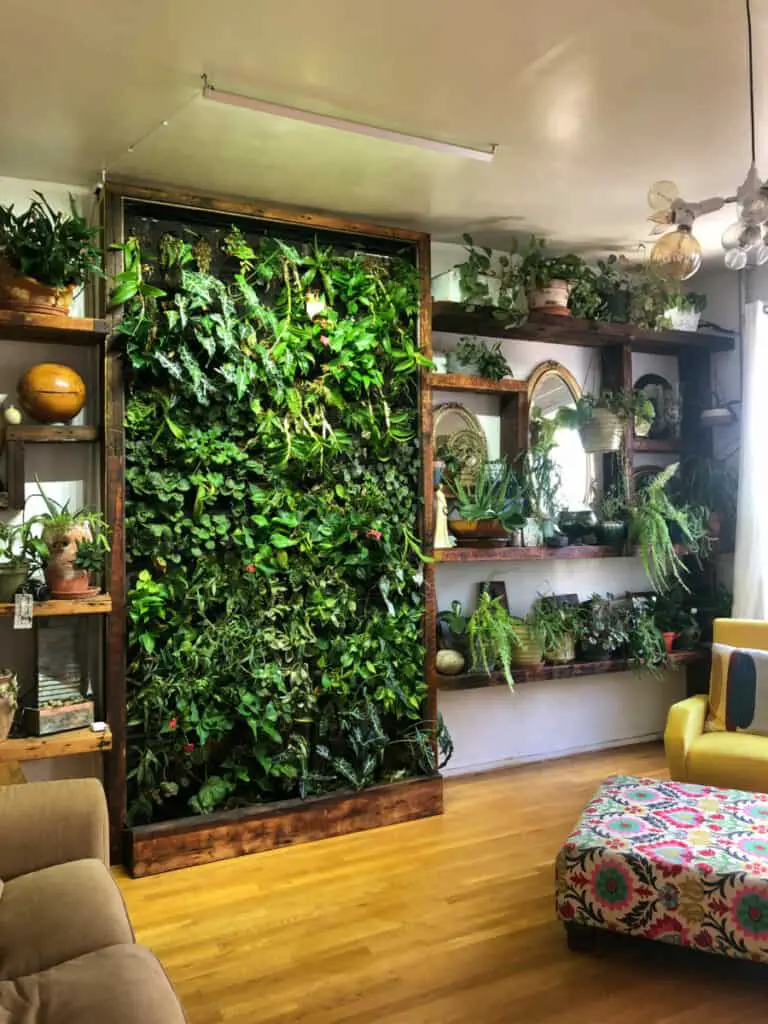This article contains affiliate links. As an Amazon Associate, SmarterHomeGardens.com earns a small commission on qualifying purchases at no extra cost to you.

It may seem obvious, but choosing the correct location for your vertical garden is one of the most important first steps on your vertical gardening journey. It isn’t as simple as placing your garden in a nice, sunny spot. There’s a lot more to consider if you want to maximize the success of your vertical garden, while also ensuring ease of maintenance and eliminating damage to adjoining or surrounding structures.
As a whole, vertical gardens are versatile structures that can be placed in many different locations inside and outside your home. Some example locations might include a porch, against a garden fence or wall, on a balcony, or even in your kitchen.
In this article, we’ll explore the very best places to set up your own vertical garden and go over all of the key considerations you need to know to maximize success and prevent issues.
Finding the best location to place your vertical garden
Regardless of location, there are some core rules that should be adhered to when considering where to put your first vertical garden that apply to any type of garden. These will be largely dictated by the plants you choose to grow but mostly, they can be considered equally and beneficial to all kinds.

Choose a location with lots of sunshine
Newsflash: plants like sunshine.
Now I know that may seem pretty obvious but let me explain a little more. All plants require light for photosynthesis, the process within a plant that converts light, oxygen, and water into carbohydrates (energy). Without it, your plants simply won’t be able to produce the energy they need and aren’t likely to succeed.
If you’re building a vertical garden outside, consider placing the garden on the northeast side (i.e. facing southwest). Make sure there aren’t any large trees or other structures that may block the light for most of the day.
Try to avoid anywhere that’s too windy
While a little wind is good and can help to keep air circulating around the plants too much can be a bad thing. Plants can react to the persistent wind by closing the pores in an effort to reduce water loss.
When the pores are closed it limited the plant’s ability to absorb carbon dioxide. Additionally, it can actually stunt growth (and fruit/veg production) by as much as 50%.
Lots of wind will also evaporate water faster in your vertical garden which can lead to plants becoming water-stressed and increasing the amount of watering needed. So, best not to pick a spot that channels too much wind if you can.
Consider the type of plants carefully
Different plants like different things. Consider carefully the amount of light each plant type needs and adjust your positioning accordingly. Try to envisage how much it will grow and if so may create a problem for your further down the line.
For example, it might not be the best idea to grow vines indoors. Vines can quickly take over the space and over-grow, making life difficult in your living room.
Choose somewhere easily accessible
Make sure you choose a location where your vertical garden isn’t going to be in your way. It should be positioned in an area where you are not going to trip over it or restrict movement.

Hanging planters should be at waist to head height and easy to reach.
Maintaining your vertical garden is generally pretty efficient, but you want to ensure it’s as easy and quick as possible. Choosing the right location and set-up can be key.
Where can a vertical garden be placed outside?
Vertical gardens are versatile, dynamic things and can be positioned almost anywhere. Where you put your vertical garden depends on the space you have at home and the type of vertical garden you’re interested in. I personally have limited indoor space, but a reasonably spacious urban garden, so have chosen to build outside. Growing outside will get better results, on average.
1. Placing a vertical garden against a wooden fence
If you’re like me, your garden is surrounded by a large, wooden garden fence. A garden fence makes a great spot to position a vertical garden. However, there are a few things to consider (that I certainly wish I knew beforehand!) before you start building.
It goes without saying that if you are building something against or hanging something off your garden fence you want it to be strong. If the fence is rotten, broken, or has weak foundations it’s probably not the best location to place your vertical garden.
I would also recommend adding a heavy-duty waterproof lining between the vertical garden and the fence for extra protection.
To improve strength, or if you don’t have access to the side of the fence with the cross beams, consider adding a backboard made from treated wood to create more of a flat surface to work with.
It may also be worth adding wood treatment to your fence to stop it from rotting. Rot can be a bit of a problem when placing or building a vertical garden against a fence, particularly if the damp soil is touching the wood. Again, a back-board can help to prevent this.
2. Placing a vertical garden against a stone or brick wall
Locating your vertical garden against or even building one into a stone or brick wall is another good option. There are plenty of ways to do this. Perhaps most simply using a pre-fabricated vertical garden ‘pouch’ system, which can be hung and/or drilled right into the wall relatively easily.

However, you will still be required to take steps to prevent damage to the wall, particularly if that wall is part of your home. Vertical gardens require water, like any other type of garden. So, it’s possible that damp soil and continuous watering can leech into the stone/brick of your house without the proper precautions.
Be sure to keep a small gap between the wall and the vertical garden system whenever possible. This can prevent water from getting into the brickwork.
It will also help to prevent molds that can break down the wall’s integrity over time.
I would also recommend adding the same heavy-duty waterproof lining between the vertical garden and the wall. If purchasing a pre-made vertical garden system, always be sure to follow the manufacturer’s recommendations for set-up.
3. Free-standing vertical gardens
Free-standing vertical garden systems are a little easier to deal with. They are the most versatile and can be positioned pretty much anywhere you like. Provided you consider the points outlined at the start of this article, you’ll do great.
There are many different types of free-standing vertical gardens that come in all shapes and sizes. Make sure you plan in advance where you are going to position them to ensure that the unit will fit in your chosen location and won’t get in the way.
This includes free-standing ‘tower garden’ systems, which are often circular at the base and don’t necessarily fit snuggly into corners.
4. Building a vertical garden on your balcony
If you don’t have a garden, you can easily build a vertical garden on a balcony. In fact, a balcony can be a great place to start a vertical garden. Any type of vertical garden system works well on a balcony (depending on how much room you have to work with).
You can create a fantastic, colorful ‘green’ wall, or I would recommend the pre-fabricated pouch growing systems that you can simply place against a side wall. Ensure that you are thinking about how you’re using water in the system though and create waterproofing as required.

Can you create a vertical garden inside your home?
Believe it or not, vertical gardens can make a great addition to the interior of your home too. Now, granted, you’re probably not going to create something that’s as rustic and messy as an outside garden. But, there are plenty of sleek, modest ideas for growing herbs, flowers, and even vegetables inside.
1. Creating a ‘living’ wall in your home
One of the most popular vertical garden design choices is a green ‘living’ wall. Living walls are increasingly popular in office buildings and urban public spaces. The are great for creating beautiful, creative spaces in your home.

These living walls are usually placed in living rooms or kitchens (and sometimes bedrooms). Since they’re mostly for decoration, a range of traditional houseplants work best such as succulents, ferns, and mosses.
A living wall still needs plenty of natural light, so don’t choose a wall that doesn’t get any natural light. You’ll also need to water plants regularly, so ensure that proper waterproofing is applied between the vertical living wall system and your wall. Otherwise, you could cause unwanted dampness and mold to form.
2. Indoor ‘smart garden’ systems
If you want a self-contained indoor gardening system with minimal fuss then there are a growing number of ‘smart garden’ growing systems that you can place indoors, even in locations without much natural light. These smart systems are made up of discreet pockets in which you place pre-filled seed pods containing all sorts of herbs and vegetables.

They usually feature an overhead light and a built-in automated water irrigation system so you can grow all year round, 24/7 with minimal mess and fuss.
I bought the Click & Grow Smart Garden 3 and it works great.
The AeroGarden Harvest Elite is another very popular system.
They are generally quite compact, which means they prefer to place on a window sill or on the kitchen counter so you can grab fresh produce whenever you are cooking.
To sum up
Due to the flexible nature of vertical gardening, there are countless different locations both inside and outside your home where you can place your very first (or even second, third, fourth…) vertical garden system.
Each location has its own unique benefits and considerations. Think ahead to how each location might affect your vertical garden over time, how convenient it is to maintain, and whether watering or other gardening activity might negatively impact adjoining or nearby structures and materials.
